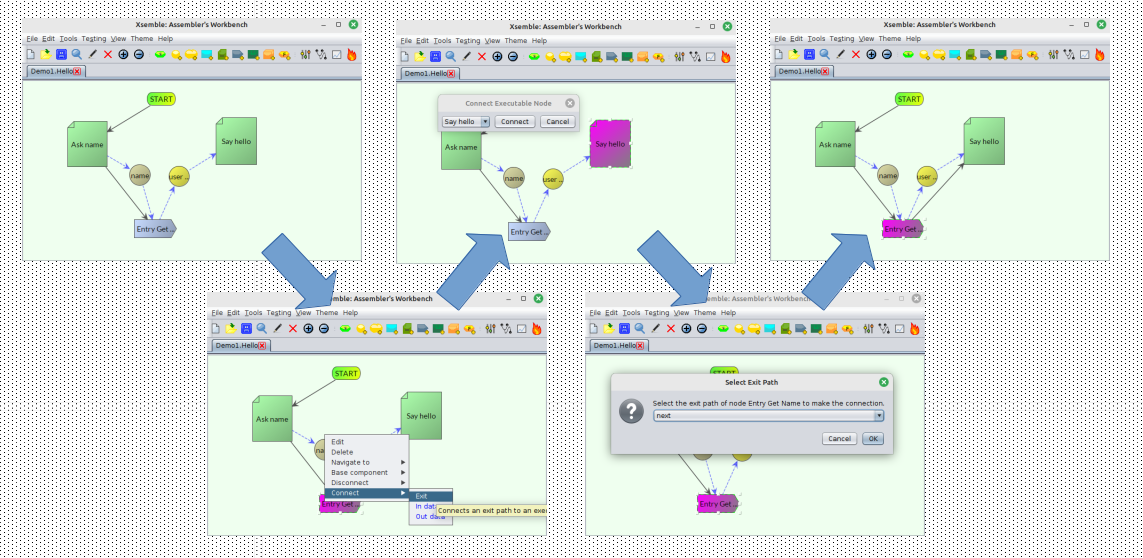We are super-excited to present Xsemble 4.6.0 today. In continuation with the theme of UX enhancements, this release takes us one more step forward, primarily through connectivity enhancements.
Simplified Connectivity
The most important enhancement in 4.6 is the simplification in the process of connecting one node to the other in the Assembler’s Workbench, in the quick design mode.

Background:
- Prior to release 4.2, the components had to be created/edited in the Developer’s Workbench and they could be used in the Assembler’s Workbench as a basis of nodes. In practice, this caused a user to keep going back-and-forth between the two tools. The Quick Design mode was introduced in release 4.2 to reduce it, so that the node’s base component, if it does not exist, can be created/edited on the fly right from the Assembler’s Workbench.
- Then in release 4.4, context-sensitive menus were introduced on an experimental basis. This made it possible to carry out some operations simply through right-clicking a node in the graph, without opening its edit dialog. These context sensitive menus kept getting enhanced about they could help the user most.
This release builds on top of these two functionalities, and improves the usability further. The context-sensitive menus were simplified; but not only that, even the sequence of operations that one has to perform for connecting nodes has now changed.
In Xsemble, connections are always made using a port (exit path, in argument or out argument) of an execution component. Previously,
- You create the other node to which to connect
- Create an appropriate port in the execution component
- Make the connection (this may be done visually through right-click functionality)
Now, in release 4.6, the step 2 is removed, amounting to 33% reduction in time. You simply make the connection graphically and choose the port later. If you are in the quick design mode (which means that the base component can be manipulated from Assembler’s Workbench), then the connection parameters of the port get adjusted as per the connecting node.
Removing step 2 also removes duplication of effort. For instance, suppose the connecting node is a transient data node that carries data using HTTP/GET method, as a URL parameter, in plain format. You already specified this while creating the data node. However, before connecting to it, you will need to create a port and repeat the connection parameters while doing it. Now with release 4.6, you do not need to do that. You simply connect visually and then let Xsemble work with adjusting the port’s connection parameters.
This makes the act of making connections very fast — almost comparable to drag-and-drop editors which are used to draw flowcharts, while Xsemble does more heavy-lifting for you.
Project Sealing
Like other components (Methods, Pages, Entry points), we now also allow a Project to be sealed or unsealed. In case of an unsealed child project, in / out arguments and exit paths may be added to it directly from where it is used as a subproject. This extends the advantages of quick design mode to the Project level as well. It also supports top-down design paradigm better.

UI Changes
Many dialog boxes have noticeable changes:
- Project Edit Dialog: New template button in front of the Layers box lets you choose the starting technology of the application quickly. Plus layout changes.
- Node Edit Dialogs: Layout changes in Data node edit dialog and Entry node edit dialog. Addition of connection parameters panel in Data node edit dialog. Additions of action buttons to Subproject node dialog to add port to the underlying child project.
- Component Implementation Dialogs: Use the template icon on the buttons to create code templates
- Component Dialogs: Spinner control for specifying component size (integer) – this gives more flexibility instead of previously pinning it to a pre-set list of Fibonacci numbers
Other Enhancements
There are some changes in the way information gets saved. The projects / repositories are automatically ported to the new version when they are opened. Those changes become permanent when one saves the project or repository. This is not a problem, unless one is looking to open the projects / repositories again in some older Xsemble release.
Some other noteworthy enhancements are:
- Context menu simplifications for Disconnect menu in Assembler’s Workbench
- Context menu for Menu nodes
- Use of layer color in port connection dialog boxes (for easy visual recall)